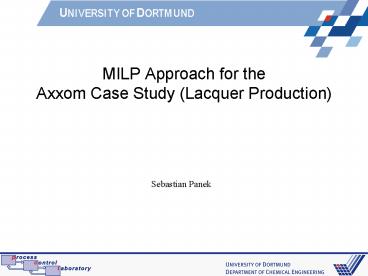MILP Approach for the - PowerPoint PPT Presentation
1 / 20
Title:
MILP Approach for the
Description:
Variable processing times on mixing vessels. start time and end time or ... Start and end times for tasks i on particular machines k ... – PowerPoint PPT presentation
Number of Views:29
Avg rating:3.0/5.0
Title: MILP Approach for the
1
MILP Approach for the
Axxom Case Study (Lacquer Production)
Sebastian Panek
2
Overview
- Problem description (Dagmar Ludewig)
- Problem characteristics
- Discrete time model
- Continuous time model
- Tests and Results
- Conclusions
3
Problem characteristics
- 29 types of lacqeur to be produced
- Some batches are too large and must be splitted
to be processed on the existing machines - Variable processing times on mixing vessels
- start time and end time or
- start time and duration must be considered for
each task
4
Problem characteristics
- Additional restrictions for tasks
- start-start restrictions
- end-start restrictions
- end-end restrictions
5
Discrete time model
- Based on the model of Kondili, Pantelides and
Sargent (1993) - Suitable for batch operations in chemical
processing - Uses the state-task network concept
1
1
Task 1
State A
State C
1
Task 2
State B
1
6
The principle of the state tasknetwork model
- Discrete time points starting times and
durations of processing steps
1
2
A
B
C
t
1
3
2
4
5
6
7
7
MILP model for the state tasknetwork
- Sets i tasks, j products,k machines
- Processing indicator variabless
- the machine k starts the execution of task i at t
- Batch size variables
- the batch size for task i on machine k at t
- Stock limitations for states
- Batch limitations for machines
8
MILP model for the state-tasknetwork
- Product flow balance
- Processing starts when external demand is created
9
Difficulties and problems
- The problem size depends essentially on the
number of time points, tasks and machines - A coarse time grid is needed to keep the model
small - A fine time grid (atmost 2h/unit) is needed to
satisfy restrictions between particular tasks - With this time grid the solution of the model
failed due to the extremely high memory usage (on
a 640 MB computer, 1 lacqeur!)
10
Continuous time model
- Another approach continuous time
- Easy formulation of restrictions on start and
processing times - Focused on tasks
- Products (states) are not considered explicitly
- Fixed batch sizes (no merging and splitting of
batches) - Capacity restrictions for states are difficult
11
MILP formulation of the continuoustime model
- Real variables for start and end times
- Binary variables for the machine allocation
- task i is processed on machine k
- Binary variables for the ordering of the tasks
- task i is processed before task h on machine k
12
MILP formulation of the continuoustime model
- 2 tasks on 2 different machines
- 2 tasks on the same machine
1
1
2
2
1
1
2
2
13
Start and end times for allocatedmachines
- Start and end times for tasks i on particular
machines k - Additional equations are needed to express
nonlinear products of binary and real variables
14
Restrictions on binary variables
- Each task must be processed on 1 machine
- If both tasks i and h are processed on machine k
then either i is before h or vice versa
15
Order restrictions
- Tasks processed on the same machine must exclude
each other - Set iff task i ends before task h
starts and set it 0 otherwise (M formulation)
16
Objective function
- Minimize the sum of latenesses of all tasks
- Alternatively other objectives like makespan or
cost minimization available
17
Tests
- After manual batch splitting 38 individual
batches to be processed - 14 machines (5 mixing vessels, 2 carussels)
- 22 tasks (8 for uni lacqeurs, 6 for metalic
lacqeurs, 8 for special metalic lacqeurs) - MILP models with different sizes up to 22
lacqeurs have been solved - Larger models are very difficult to solve
18
Gantt diagramm for 20 lacqeurs
19
Solution with GAMS/Cplex
- Integer solutions for a problem with 10 lacqeurs
- Node Objective Time
- 185 10607 lt20s
- 1031 2469 36s
- 2015 669 56s
- 3962 185 92s
- Poor solution can be obtained quickly, good
solutions need much time and memory.
20
Conclusions
- The continuous time model requires smaller models
and therefore is easier to solve - The discrete time model is more flexible and
powerful (batch merging and splitting, external
components, product restrictions) - Both types are strongly limited with respect to
the solution time of large models - A kind of meta-strategy (i.e. moving horizon) is
needed to solve large models































